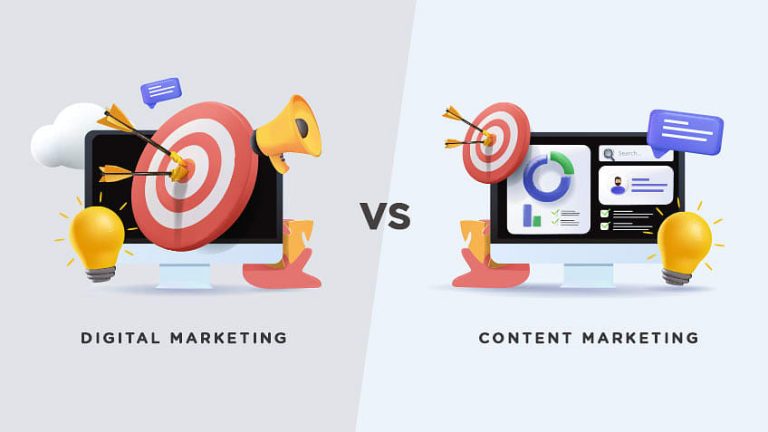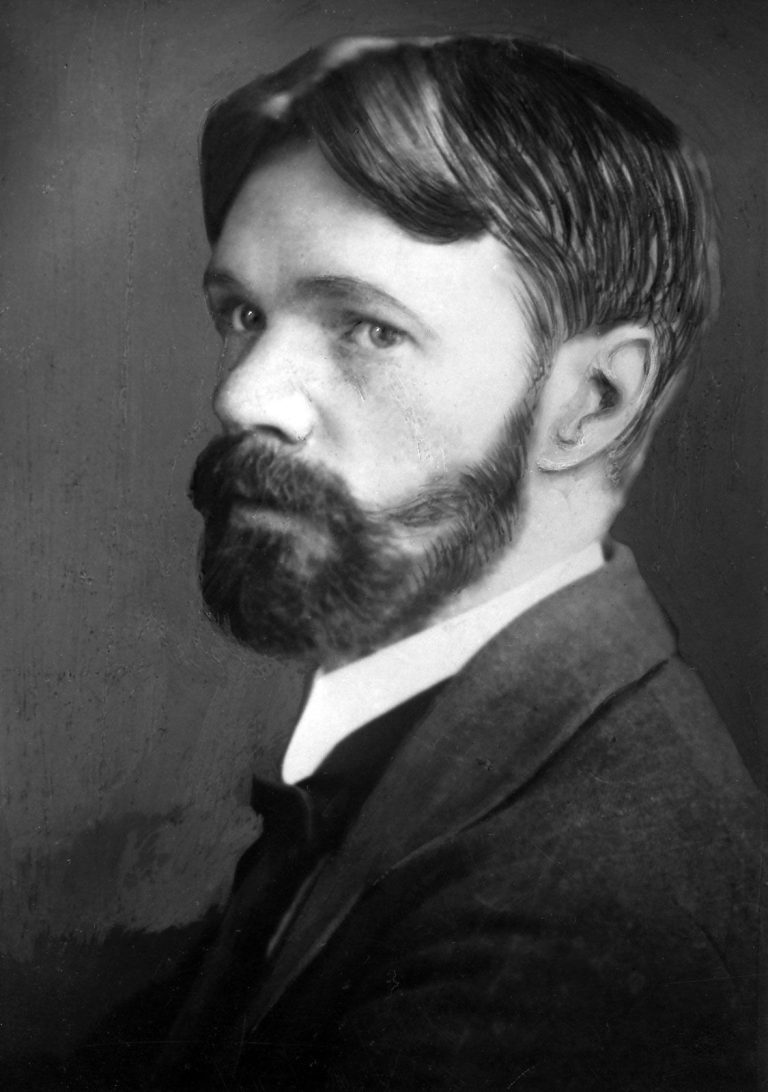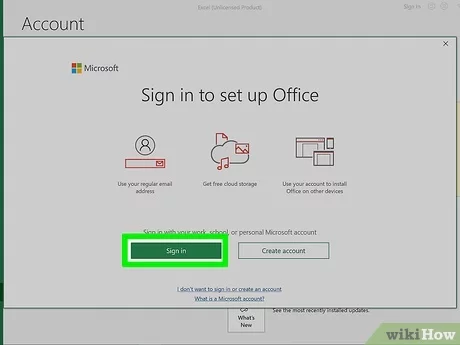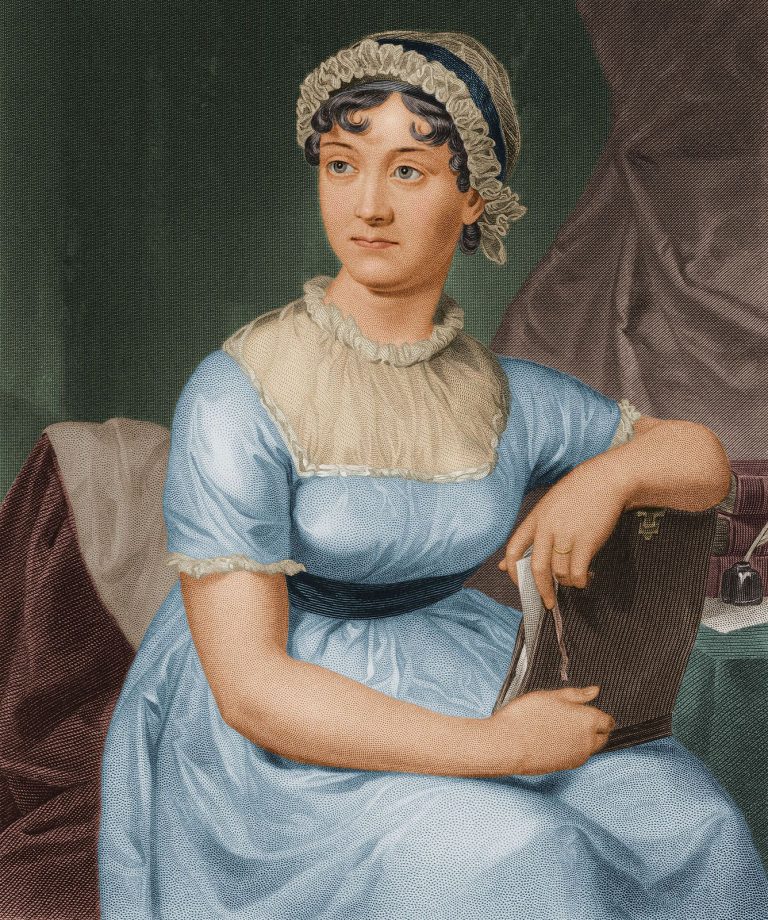Digital marketing leverages online channels to reach audiences, while traditional marketing utilizes offline methods such as print and TV. Both strategies aim to build brand awareness and promote products.
In today’s rapidly digitalizing world, understanding the distinctions between digital marketing and traditional marketing is essential. Digital marketing encompasses a range of online practices, from social media campaigns and email blasts to SEO and content marketing. It allows for dynamic interaction between businesses and customers, providing real-time engagement and analytics.
Traditional marketing, on the other hand, might include billboards, flyers, or radio spots – offline techniques with broader, less targeted reach. As consumer behavior shifts increasingly towards online platforms, the importance of digital marketing becomes ever more pronounced. Marketers need to master different techniques to optimize their reach and measure the impact effectively. Brands looking to thrive must skillfully navigate the blend of digital and traditional marketing tactics to ensure maximum visibility and engagement.
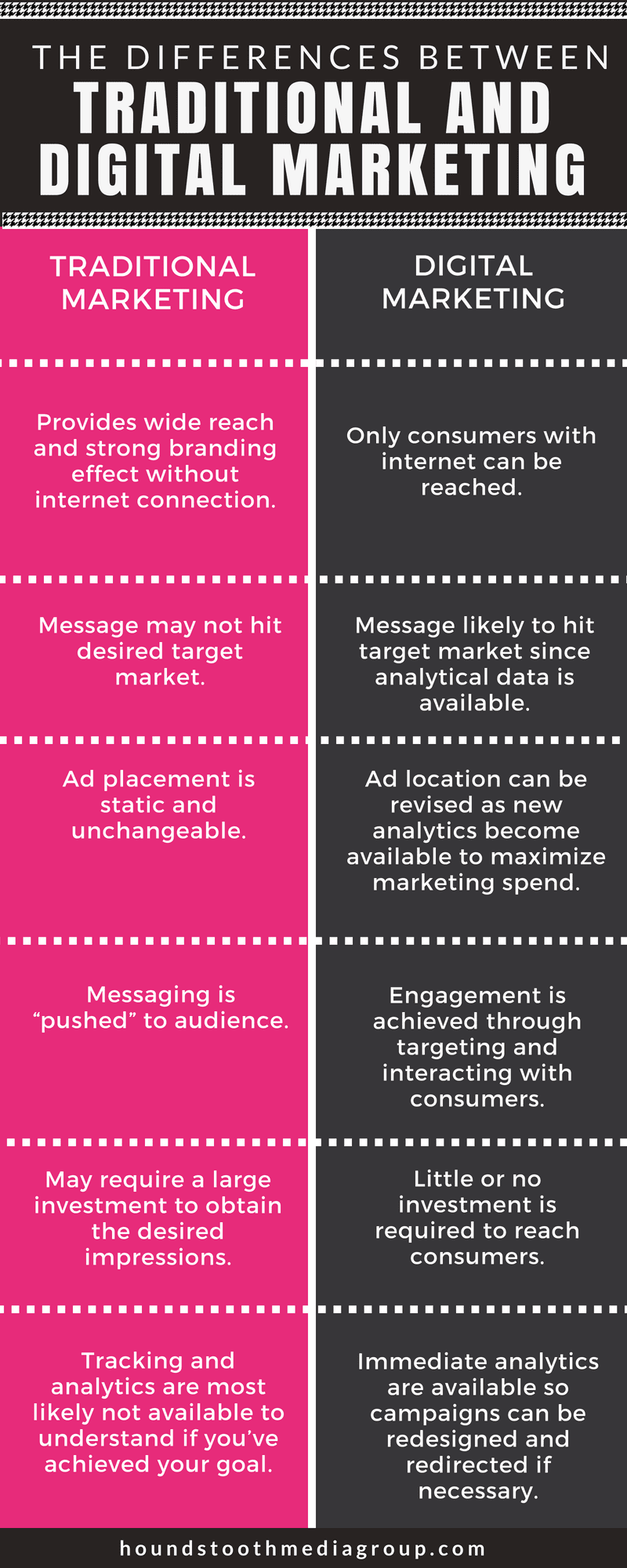
Credit: houndstoothmediagroup.com
Digital Marketing Vs Traditional Marketing: A Primer
In a world where screens dominate our attention, the battle between digital and traditional marketing rages on. Businesses and marketers often face the challenge of choosing the right approach. Let’s dive into the core principles that set them apart and assess the current landscape.
Core Principles
Digital marketing thrives on data and analytics, while traditional marketing relies more on broadcast tactics. Here is a simple breakdown:
| Digital Marketing | Traditional Marketing |
|---|---|
| Targets specific audiences | Reaches local demographics |
| Engages through digital channels | Uses print, TV, radio |
| Measures success with real-time data | Tracks results over time |
| Adapts quickly to changes | Follows a set campaign course |
Current Landscape
The digital realm is ever-growing. Online platforms and social media are crucial for modern businesses. Traditional marketing methods remain valuable for certain audiences. The two approaches can work together:
- Digital channels enhance brand presence online
- Traditional methods lend credibility and tangibility
Digital marketing is more cost-effective and trackable. Traditional marketing offers sensory experiences through physical ads. Both approaches are vital in a robust marketing strategy.
Evolution Of Traditional Marketing
Before the buzz of keywords and viral videos, marketing had a more tangible feel. Brands reached out through media that you could touch, hear, and see live. This journey through time reveals how traditional marketing shaped the consumer’s world and laid the foundation for the digital age.
Historical Milestones
Traditional marketing has a rich history full of memorable campaigns and methods. Let’s look at some standout moments:
- Print Advertising: It all starts with the first print ad in 1472.
- Billboards: Large-scale ads took over the streets in the 1830s.
- Radio Ads: The airwaves got commercial in the 1920s.
- TV Commercials: The first TV ad aired in 1941, changing the game entirely.
- Telemarketing: The 1970s saw marketing through phone calls.
- Direct Mail: Personalized touch with mailers became popular in the 1980s.
Key Traditional Channels
Traditional marketing built relationships using key channels. Each had a unique impact:
| Channel | Description | Impact |
|---|---|---|
| Magazines, newspapers, and flyers. | Audience engagement through reading. | |
| Billboards | Large signs on roads and buildings. | Visual catch for drivers and passersby. |
| Radio | Ads played between programs. | Entertains and informs a listening audience. |
| Television | Ads mingled with shows and movies. | Family audiences reached in their homes. |
| Direct Mail | Personal letters, catalogues, and postcards. | Direct reach to consumer’s homes. |
Rise Of Digital Marketing
Imagine a world without social media, search engines, and online ads. Hard to picture, isn’t it? That’s the dynamic shift digital marketing has brought into our everyday lives, eclipsing traditional methods at a speed that’s nothing short of remarkable.
Internet’s Impact
With the internet came a new era. Suddenly, the way we connect, shop, and find information changed. Brands noticed this shift. They began crafting strategies to meet people where they spend most of their time: online. The internet offers a 24/7 connection to potential customers. It’s a tool for constant engagement and personalized experiences.
Key highlights of the internet’s influence include:
- Vast reach: It connects businesses to millions worldwide.
- Targeted advertising: Ads tailored to specific demographics are now possible.
- Data-driven insights: Real-time data helps tailor marketing efforts like never before.
- Cost-effective: Often less expensive than traditional methods.
- Two-way communication: Instant feedback from customers helps brands adjust quickly.
Digital Marketing Tools And Platforms
Imagine having an arsenal of tools at your fingertips. That’s what digital marketers have to engage with customers. These tools allow for tracking, analysis, and strategy refinement on-the-go.
The most commonly used digital marketing tools and platforms include:
| Tool/Platform | Function |
|---|---|
| Google Analytics | Tracks website activity. |
| SEO Software | Boosts online visibility. |
| Social Media Channels | Engages with customers. |
| Email Marketing | Personalizes communication. |
| Content Management Systems | Streamlines content creation. |
Each digital marketing tool and platform offers different benefits. Together, they form a cohesive strategy for reaching and converting customers. With these tools, businesses can measure the impact of their efforts and adjust on the fly for better results.
Audience Reach And Segmentation
Understanding how to reach and understand your audience is key in marketing. Let’s dive into how digital and traditional marketing differ in accessing and engaging with potential customers.
Global Vs Local Approach
Digital marketing removes geographical barriers. It allows businesses to share their message worldwide. This means you can have customers across the globe. Traditional marketing often focuses on local or regional audiences. It uses mediums like newspapers and billboards that reach people in a specific area.
Target Audience Precision
Digital marketing excels in precision targeting. It uses online data to reach specific groups. Tools like social media ads can target by age, interests, or behaviors. Traditional marketing is broader. It often targets anyone who comes across the ad. This can make reaching the ideal customer harder.
Let’s compare the two with some examples:
| Marketing Type | Audience Reach | Segmentation Ability |
|---|---|---|
| Digital Marketing | Global | High Precision |
| Traditional Marketing | Local/Regional | General |
A precise target means less wasted resources and better results. In digital spaces, businesses tailor messages to the right eyes. With traditional methods, the net thrown is wide and catches all, with less finesse.
Analyzing Cost-effectiveness
Understanding the cost-effectiveness of digital versus traditional marketing comes down to evaluating how resources are allocated and the return on investment (ROI) each generates. Let’s peel back the financial layers and compare the two.
Marketing Budget Allocation
Digital marketing often requires a lower budget than traditional marketing. Here’s why:
- Social media campaigns can be adjusted as needed, saving costs.
- Pay-per-click (PPC) advertising allows for tight budget control.
- Email marketing offers high impact with minimal expenses.
- Higher costs for print or broadcast media space.
- Expenses linked to physical materials like brochures or billboards.
- Less flexibility in modifying campaigns once launched.
In contrast, traditional marketing usually involves:
Roi Metrics Comparison
Digital marketing provides clear analytics and metrics that make tracking ROI straightforward. Consider these aspects:
| Digital Marketing ROI | Traditional Marketing ROI |
|---|---|
| Click-through rates (CTR) | Customer surveys |
| Conversion rates | Sales volume |
| Website traffic analysis | Reach and frequency estimates |
Tracking digital campaigns is immediate and actionable. Traditional marketing requires more guesswork, leading to a challenge in measuring ROI accurately.

Credit: www.lyfemarketing.com
Engagement And Interaction
The digital landscape has revolutionized customer engagement and interaction, marking clear distinctions from traditional marketing practices. Today’s consumers expect dynamic conversations and personalized experiences with brands. Let’s dive into how digital marketing answers these expectations, especially through effective customer relationship management and leveraging user-generated content.
Customer Relationship Management
Customer relationship management (CRM) is key in fostering brand loyalty and retention. Digital channels allow for immediate, data-driven interactions.
- Email campaigns can be personalized based on customer actions.
- Social media allows for instant feedback and direct conversation.
- Analytics tools track customer preferences to tailor future content.
User-generated Content
User-generated content (UGC) is a powerful asset in digital marketing. It fosters community and authenticity.
- Customers share their experiences through reviews and testimonials.
- Photo and video contests on platforms like Instagram encourage content creation.
- Hashtag campaigns inspire users to generate related content.
Measuring Success
Understanding how effective your marketing campaign has been is crucial. Whether using digital or traditional methods, knowing your success rate helps plan future campaigns. Let’s explore measuring success in both realms.
Analytics In Digital Marketing
Digital marketing shines in its ability to track performance in real-time. Various tools provide insights into a campaign’s performance. Here, analytics become your best friend.
- Google Analytics: It reveals user behavior, website traffic, and conversion rates.
- Social Media Insights: Platforms like Facebook and Instagram offer detailed reports on engagement and reach.
- SEO Tools: They show how well your content ranks on search engines.
Tables can also illustrate data comparison effectively:
| Tool | Function |
|---|---|
| Google Analytics | Tracks website traffic |
| Social Media Insights | Measures post engagement |
| SEO Tools | Assesses keyword success |
Success Metrics In Traditional Marketing
Traditional marketing success metrics can be harder to gauge. Tools and strategies differ from their digital counterparts. Tangible engagement metrics are a key focus.
- Surveys: Gain feedback directly from consumers.
- Sales Figures: Reflect the direct impact of campaigns.
- Audience Reach: Estimates how many people saw the ad.
An example of tracking traditional marketing success may look like this:
- Tally coupons used from a magazine ad.
- Count inquiries following a billboard display.
- Compare sales before and after an ad campaign.
Choosing The Right Marketing Approach
Deciding on the best marketing method is key to business success. With numerous channels available, it’s vital to choose the one that fits your brand. This means understanding the nuances between digital marketing and traditional marketing.
Business Model Considerations
Your business model shapes your marketing choices. Certain products thrive through digital campaigns. Others benefit from the tangibility of traditional methods. Consider these points:
- Target Audience: Know where they spend their time.
- Budget: Balance cost with expected returns.
- Reach: Decide if you need a local or global presence.
- Engagement: Determine the interaction level with customers.
Integrating Marketing Strategies
The most effective approach often combines digital and traditional marketing. This integration caters to a broader audience. Look at this table:
| Strategy | Digital | Traditional |
|---|---|---|
| Brand Awareness | Social Media Ads | Billboards |
| Customer Engagement | Email Campaigns | Direct Mail |
| Conversion | Online Ads | TV Commercials |
Test and learn to see which combination yields the best results. You might be surprised by the power of a well-rounded marketing mix.
Future Trends
As we peer into the future, the evolution of marketing stands clear. Digital and traditional marketing reveal diverse trajectories. Understanding these anticipated courses is key. Here, we’ll explore future trends impacting the world of marketing.
Predictions In Digital Marketing
Predictive algorithms will drive tomorrow’s digital marketing strategies. Personalization will reach new heights. Businesses will leverage AI for real-time decision making. Future digital strategies include:
- Advanced personalization techniques
- Integration of virtual reality (VR)
- AI-driven chatbots for customer service
- Emphasis on voice search optimization
Adapting To Changes In Consumer Behavior
Consumer dynamics shifts call for adaptability. Marketers buzz about these transformations:
| Trend | Implication |
|---|---|
| Increased Mobile Usage | Optimize for mobile-first experiences |
| Sustainability | Focus on eco-friendly practices |
| Brand Interaction | Engage through social media platforms |
| Data Privacy | Adhere to privacy regulations |
Interaction with brands evolves as customers seek authentic experiences. Marketers must blend digital savvy with a deep understanding of consumer shifts.
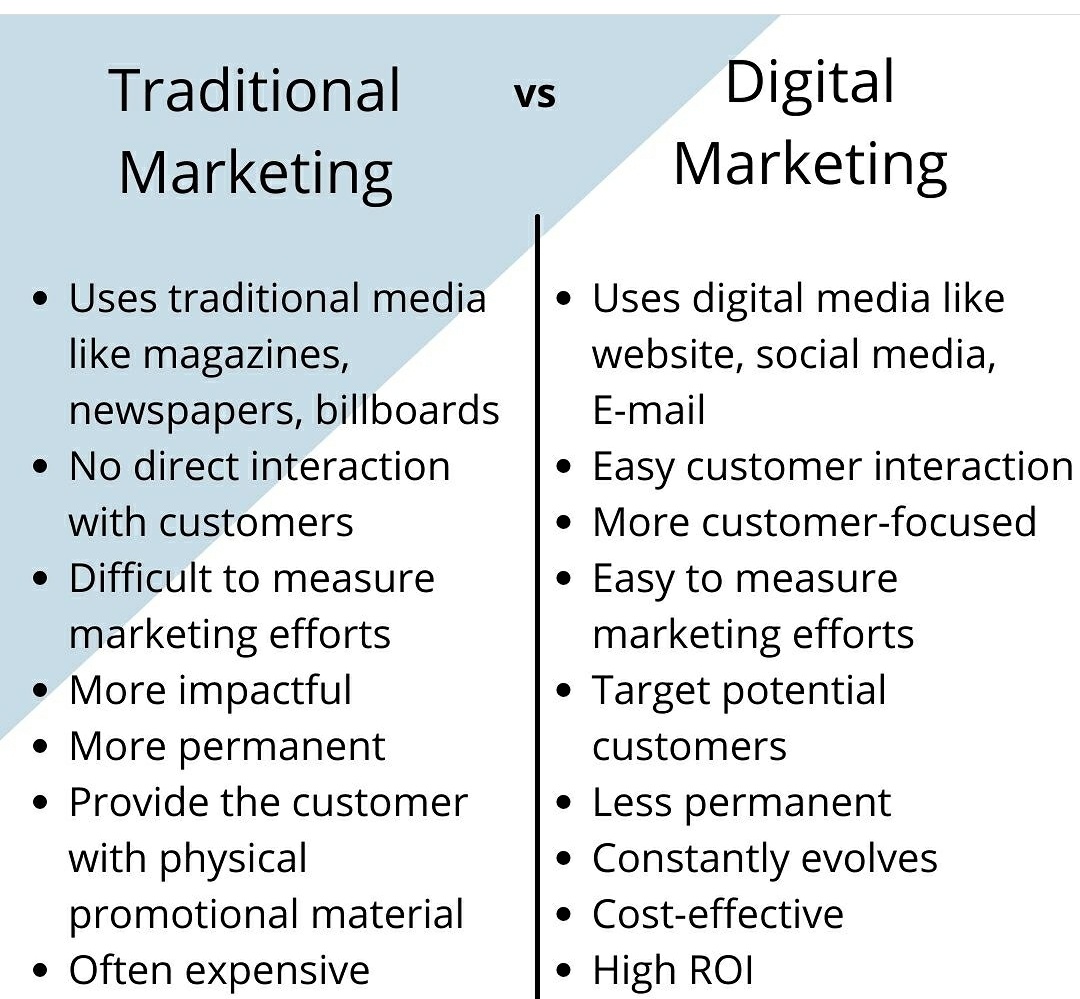
Credit: twitter.com
Frequently Asked Questions On What Is The Difference Between Digital Marketing And Traditional Marketing
What Is Digital Marketing?
Digital marketing involves promoting products or services using digital channels, typically the internet, and digital devices like smartphones. It engages audiences through search engines, social media, email, and other platforms.
How Does Traditional Marketing Work?
Traditional marketing uses offline methods like print ads, billboards, television, and radio broadcasts. It focuses on reaching a broad audience, typically within a specific locality, through physical media channels.
What Are The Costs Of Digital Vs. Traditional Marketing?
Typically, digital marketing can be more cost-effective than traditional marketing. It allows for precise targeting and detailed analytics, which can result in better cost-efficiency. Traditional marketing involves higher costs for production and placement.
Can Traditional Marketing Reach Online Users?
Traditional marketing primarily targets offline audiences, though QR codes or URLs in print media can bridge the gap to online platforms. However, it’s less effective for purely online engagement compared to digital strategies.
Conclusion
Navigating the marketing landscape requires an understanding of both digital and traditional realms. Recognizing their unique advantages empowers businesses to craft effective strategies. As consumer behavior evolves, blending these approaches can offer the best results. Embrace change, test different methods, and find your brand’s sweet spot in the marketing mix.


